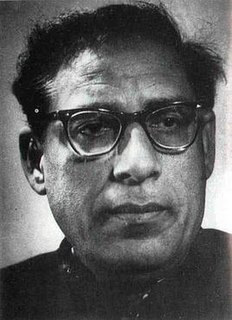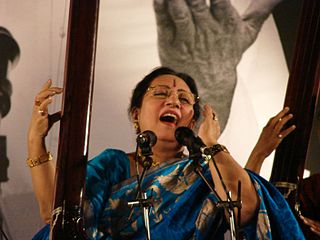This article is being considered for deletion in accordance with Wikipedia's deletion policy. Please share your thoughts on the matter at this article's deletion discussion page. |
This article has multiple issues. Please help improve it or discuss these issues on the talk page . (Learn how and when to remove these template messages) (Learn how and when to remove this template message)
|
A raga or raag is a complex structure of musical melody used in Indian classical music. It is a set of rules of how to build a melody which can ignite a certain mood in the reciter and listeners. The Sikh holy scripture, Guru Granth Sahib Ji, is composed in and divided into a total of 60 ragas. This is a combination of 39 single raags and 21 mixed (or "mishrit") raags (a raag composed by combining two or three raags together). Each raga is a chapter or section in the Guru Granth Sahib starting with Asaa raag . All raags in the Guru Granth Sahib Ji are named as "Raag".
Following is the list of all sixty Raags (including 39 main raags and 21 "mishrit" raags) under which Gurbani is written, in order of appearance with page numbers.
1. Asa ------------------------08
2. Gujari --------------------10
3. Gauri Deepaki -------------12
4. Dhanasri ------------------13
5. Gauri Poorabi -------------13
6. Sri ----------------------14
7. Majh ----------------------94
8. Gauri Guarairee ----------151
9. Gauri --------------------151
10. Gauri Dakhani ------------152
11. Gauri Chaitee ------------154
12. Gauri Bairagan -----------156
13. Gauri Poorabi Deepaki -----157
14. Gauri Majh ----------------172
15. Gauri Malva ----------------214
16. Gauri Mala ----------------214
17. Gauri Sorath --------------330
18. Asa Kafi ------------------365
19. Asavari -----------------369
20. Asa Asavari - --------------409
21. Devgandhari ---------------527
22. Bihagra -------------------537
23. Vadhans -------------------557
24. Vadhans Dakhani ------------580
25. Sorath --------------------595
26. Jaitsri --------------------696
27. Todi ----------------------711
28. Bairarri -------------------719
29. Tilang --------------------721
30. Tilang Kafi ----------------726
31. Suhee ----------------------728
32. Suhee Kafi -----------------751
33. Suhee Lalit ----------------793
34. Bilaval --------------------795
35. Bilaval Dakhani ------------843
36. Gound ----------------------859
37. Bilaval Gound --------------874
38. Ramkali --------------------876
39. Ramkali Dakhani ------------907
40. Nut Narayan ----------------975
41. Nut ------------------------975
42. Mali Gaura -----------------984
43. Maru -----------------------989
44. Maru Kafi -----------------1014
45. Maru Dakhani --------------1033
46. Tukhari -------------------1107
47. Kedara --------------------1118
48. Bhairo --------------------1125
49. Basant --------------------1168
50. Basant Hindol -------------1170
51. Sarang --------------------1197
52. Malar ---------------------1254
53. Kanra ---------------------1294
54. Kaliyan ------------------1319
55. Kaliyan Bhopali -----------1321
56. Parbhati Bibhas -----------1327
57. Parbhati ------------------1327
58. Parbhati Dakhani-----------1344
59. Bibhas Parbhati -----------1347
60. Jaijavanti ---------------1352
Mishrat Raags of Sri Guru Granth Sahib:
1. Gauri Deepaki
2. Gauri Poorabi
3. Gauri Guarairee
4. Gauri Chaitee
5. Gauri Bairagan
6. Gauri Poorabi Deepaki
7. Gauri Malva
8. Gauri Mala
9. Gauri Majh
10. Gauri Sorath
11. Asa Kafi
12. Asa Asavari
13. Tilang Kafi
14. Suhee Kafi
15. Suhee Lalit
16. Bilaval Gound
17. Maru Kafi
18. Basant Hindol
19. Kaliyan Bhopali
20. Parbhati Bibhas
21. Bibhas Parbhati
Single Raags of Sri Guru Granth Sahib:
1. Asa
2. Gujari
3. Dhanasri
4. Siri
5. Majh
6. Gauri
7. Gauri Dakhani (Since Dakhani is not a raag. Hence this raag is not considered as Mixed (Mishrit)).
8. Asavari
9. Devgandhari
10. Bihagra
11. Vadhans
12. Vadhans Dakhani
13. Sorath
14. Jaitsri
15. Todi
16. Bairarri
17. Tilang
18. Suhee
19. Bilaval
20. Bilaval Dakhani
21. Gound
22. Ramkali
23. Ramkali Dakhani
24. Nut
25. Nut Narayan
26. Mali Gaura
27. Maru
28. Maru Dakhani
29. Tukhari
30. Kedara
31. Bhairo
32. Basant
33. Sarang
34. Malhar
35. Kanra
36. Kaliyan
37. Parbhati
38. Parbhati Dakhani
39. Jaijaivanti
Raags are used in Sikh music simply to create a mood, and are not restricted to particular times. A mood can be created by the music of the raag regardless of the time of day. There are a total of 60 raags or melodies within the Guru Granth Sahib. Each melody sets a particular mood for the hymn, adding a deeper dimension to it. The Guru Granth Sahib is thought by many to have just 31 raags or melodies which is correct of single raags. However, combined with "mishrit" raags, that total is 60.









